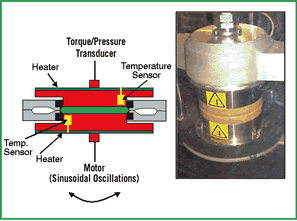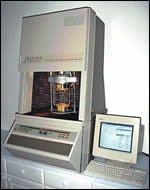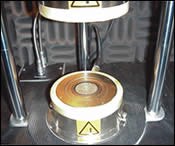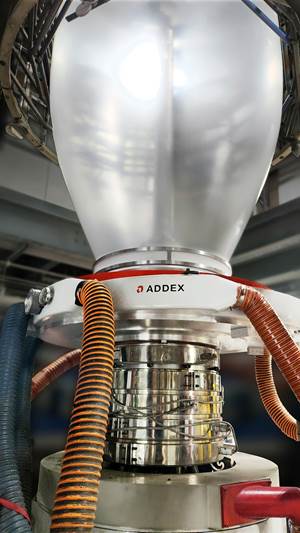Novel Rheometer Tells More About Thermoplastic Processing Behavior
A unique type of oscillating-die rheometer, first unveiled in 1999 for analyzing thermosets and composites, has now been upgraded for testing polyolefins and other thermoplastics.
A unique type of oscillating-die rheometer, first unveiled in 1999 for analyzing thermosets and composites, has now been upgraded for testing polyolefins and other thermoplastics. This instrument reportedly provides more information about the processing characteristics of resins—data that previously required two or more instruments at much higher cost.
The APA 2000 Advanced Polymer Analyzer was developed by Alpha Technologies, a maker of laboratory instrumentation for rubbers and other polymers, which became a business unit of Dynisco LLC last year. According to Tom Mlinar, Alpha’s v.p., of sales and services, the updated APA 2000 is unique in its ability to fully characterize polymers in a single test, measuring the dynamic mechanical properties before, during and after cure (for thermosets) or melt solidification. Plastics processors and compounders can simulate exact process conditions to determine the impact of processing on part quality and performance. Test capabilities include isothermal cure, controlled stress or strain, linear or nonlinear temperature ramps, temperature sweeps, frequency sweeps, and strain sweeps.
Mlinar says that to obtain the breadth of information achievable with this one instrument would typically require tests on a Mooney rheometer plus a DMA (dynamic mechanical analyzer) and probably also a capillary rheometer. The APA 2000 is about twice the cost of a typical Mooney or capillary rheometer, yet half the cost of a DMA.
The APA 2000 has a special temperature-control system, a sealed and pressurized sample cavity, and a unique sample handling technique, all of which are said to contribute to highly repeatable measurements of viscosity, gel time, cure time, crystallization rate, final shear modulus, and glass-transition temperature (Tg). The unit is also reportedly simple to use, with even the most complex tests programmed and data retrieved easily via the system’s multi-tasking operator interface. Minimal sample preparation time is required and testing is initiated by a single keystroke.
How it works
An oscillating parallel-plate rheometer, the APA 2000 differs from a Mooney viscometer or a typical dynamic rotational rheometer in that it has two permanent (rather than disposable) parallel flat dies or plates oscillating against each other. The lower die creates stress on the material as it turns relative to the upper, stationary die. The latter has a very precise torque and pressure transducer that measures the stress applied to the sample by the bottom die.
A Mooney viscometer consists of a die in a closed cavity and a rotor that turns in one direction at a set rate. Other types of rotational or bi-conical rheometers are configured similarly to the APA 2000, with the bottom die oscillating and the top die receiving the information. A typical parallel-plate instrument used to characterize thermosets and thermoplastic melts requires disposable plates. Both Mooney viscometers and other typical rotational rheometers are isothermal—operating at a constant temperature. The APA 2000 is said to be unique in that it performs tests over a precise temperature gradient.
According to Mlinar, the APA “differs in the way that we hold that sample and transmit torque to the sample and then into the upper die with transducer to read the results. Its reading is much more accurate than what is typically achieved with a Mooney viscometer.”
Compared with a typical rheometer, the instrument provides more information on attributes of the material such as long-chain branching. It also allows users to learn more about recrystallization rates. “With its very rapid and precise heating and cooling system, you can quickly change resin powders or pellets into liquids and then resolidify in order to find out what happens to that material. Compounders and molders can be in a better position to understand what is driving their process variances.”
Another key upgrade is the increased sensitivity achieved by the instrument’s new and more precise electric servomotor, which is controlled via 1.1 million pulses/revolution, versus 630,000 pulses/rev with its predecessor. Results can be obtained in 10 to 12 min with the APA 2000, about half the time for a typical rheometer, Mlinar says.
Related Content
Novel Air Ring Solves Gauge Variations for Film Processor
Crayex installs Addex gauge-controlling air ring built for rotating/oscillating dies on a problematic line and notices dramatic improvement in thickness variations.
Read MoreAuto-Profile System for Blown Film Rotating Dies
NPE2024: New technology can slash gauge variation by 50%.
Read MoreNew Rotary Die and Cam Lock Design for Tubing
NPE2024: New design enables quick and easy assembly and disassembly of the crosshead, and eliminates the socket head cap screws.
Read MoreMedical Tubing: Use Simulation to Troubleshoot, Optimize Processing & Dies
Extrusion simulations can be useful in anticipating issues and running “what-if” scenarios to size extruders and design dies for extrusion projects. It should be used at early stages of any project to avoid trial and error and remaking tooling.
Read MoreRead Next
For PLASTICS' CEO Seaholm, NPE to Shine Light on Sustainability Successes
With advocacy, communication and sustainability as three main pillars, Seaholm leads a trade association to NPE that ‘is more active today than we have ever been.’
Read MoreSee Recyclers Close the Loop on Trade Show Production Scrap at NPE2024
A collaboration between show organizer PLASTICS, recycler CPR and size reduction experts WEIMA and Conair recovered and recycled all production scrap at NPE2024.
Read More
















